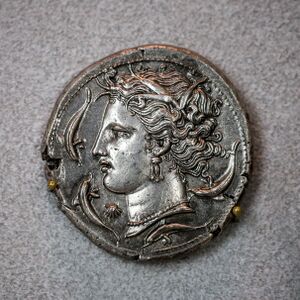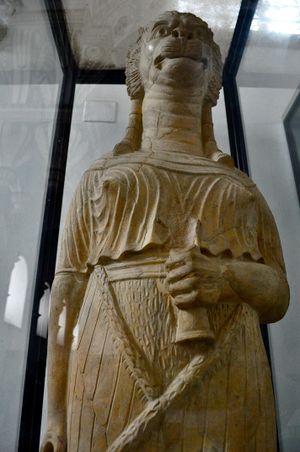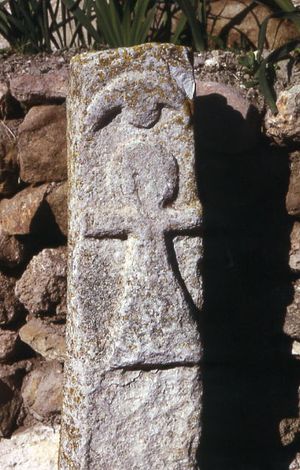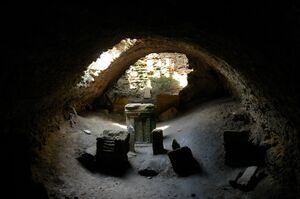تانيت

| الدين في الشرق الأدنى القديم |
|---|
تانيت' "تعنيت" "Tanit" هي المعبود الأعلى في قرطاج بجانب زوجها بعل حمون.[1][2] وهي مماثلة لعشتار الفينيقية والبابلية، وأصلها فينيقي الهة الخصوبة والسماء ، وهي حامية مدينة قرطاج البونيقية. تعتبر هذه الالهة الاشهر في قرطاج ، ويطلق عليها لقب "وجه بعل" وهي احتلت منذ القرن الخامس قبل الميلاد المرتبة الاولى في النصوص القرطاجية واستمرت عبادتها حتى بعد زوال قرطاج، وكان لها معبد في روما، وعثر على معبد لها في دوجا وسط سور نصف دائري ، وسمها الرومان جونو كايليتيس، إلهة الخصب والأمومة.
أصلها
افترض ج. گاربيني من جهته ان تكون تانيت إلهة أصيلة مدينة صيدا بلغت قرطاج اثر الغزو الفارسي في ذلك الوقت كانت صيدا تحتل المنزلة الاولى بين المدن الفينيقية. و من هذا المنطلق يعتبر الباحث الإيطالي تبني قرطاج لعبادة تانيت انعكاسا للعلاقات الوثيقة التي جمعت قرطاج بصيدا ودليلا على حدوث اصلاح ديني استمد جذوره من التحولات الاقتصادية و السياسية التي شهدتها قرطاج اثر هزيمة هيمراس . أيضا مايؤكد على ان الالهة تانيت اصلها من صور هو ان قرطاج لطالما اعتبرت صور هي مدينتها الام بشهادة المصادر الاغريقية والرومانية. لقد قدمت النقيشة المكتشفة في ساربتا 15 كلم جنوب صيدا دليلا قويا على ذلك , و هي ترجع لاواسط القرن السادس قبل الميلاد , يضاف إلى ذلك مواقع كثيرة في لبنان تعكس على مانرجح وجود هذه العبادة كعين تانيت وكفرتبنيت وعقتنيت وعيتنيت وعيتيت , ونذكر اخيرا الدعم الذي قدمته النقيشة قرطاج التي تشير إلى تانيت بلبنان. تبدو تانيت من خلال النصوص القرطاج بمظهر الالهة المرتبطة بآلهة أخرى، وهي عشتروت كما هو الحال في ساربتا ومالطا وقرطاج.
The name appears to have originated in Carthage (modern day Tunisia), though it does not appear in local theophorous names.[3] She was equivalent to the war goddess Astarte, and later worshipped in Roman Carthage in her Romanized form as Dea Caelestis, Juno Caelestis, or simply Caelestis. Before 1955, the only attestations of the goddess's name were in Phoenician, which is written without vowels. It was arbitrarily vocalized as "Tanit". In 1955, Punic inscriptions transliterated in Greek characters found at El-Hofra (near Constantine, Algeria) transliterated the name as باليونانية: Θινιθ (Thinith) and باليونانية: Θεννειθ (Thenneith). The inscriptions indicate that the name was likely pronounced as Tinnīt.[4] Still, many scholars and writings continue to use Tanit.
In modern-day Tunisian Arabic, it is customary to invoke Omek Tannou or Oumouk Tangou ('Mother Tannou' or 'Mother Tangou', depending on the region), in years of drought to bring rain.[5] Similarly, Algerian, Tunisian and many other spoken forms of Arabic refer to "Baali farming" to refer to non-irrigated agriculture.[6] Such usage is attested in Hebrew, a Canaanite language sister to Phoenician, already in the 2nd century CE Mishnah.[7]
العبادة
Tanit was worshiped in Punic contexts in the Western Mediterranean, in Sicily, Malta, North Africa, Gades and many other places into Hellenistic times.
Tanit's worship might have originated in relation to the Phoenician deity Astarte (Ishtar), whose own worship is first dated in the Phoenician sites of Sidon and Tyre. Her shrine excavated at Sarepta in southern Phoenicia revealed an inscription that has been speculated to identify her for the first time in her homeland and related her securely to the Phoenician goddess Astarte (Ishtar).[8] Iconographic portrayals of both deities later become similar.[9][10] The relation between both deities has been proposed to be hypostatic in nature, representing two aspects of the same goddess.[11][10]
From the fifth century BCE onwards, Tanit's worship is associated with that of Baal Hammon. She is given the epithet pene baal ('face of Baal') and the title rabat, the female form of rab ('chief').[12] In North Africa, where the inscriptions and material remains are more plentiful, she was, as well as a consort of Baal Hammon, a heavenly goddess of war, a "virginal" (unmarried) mother goddess and nurse, and, less specifically, a symbol of fertility, as are most female forms.[13] Tanit worship became popular in the Tyrian colony of Carthage, especially after the separation between Carthage and Tyre in the fifth century BCE, when the traditional Phoenician cults of Astarte and Melqart were displaced by the Punic worship of Tanit and Baal Hammon.[11]
Several of the major Greek goddesses were identified with Tanit by the syncretic interpretatio graeca, which recognized as Greek deities in foreign guise the gods of most of the surrounding non-Hellene cultures.
Phoenicians spread the cult of Tanit-Astarte to the Iberian Peninsula with the foundation of Gadir (modern day Cádiz) and other colonies, where the goddess might have been also assimilated to native deities. Her worship was still active after the Roman conquest, when she was integrated with the Roman goddess Juno (along with elements from Diana and Minerva) in a goddess named Dea Caelestis, the same way Baal Hammon was assimilated to Saturn. Dea Caelestis retained Punic traits until the end of classical antiquity in the fourth century CE.[11][10] Similarly, long after the fall of Carthage, Tanit was still venerated in North Africa under the Latin name of: Juno Caelestis, for her identification with Juno.[14] Ancient Berbers of North Africa also adopted the Punic cult of Tanit.[15]
التصوير الأيقوني
Her symbol (the sign of Tanit), found on many ancient stone carvings, appears as a trapezium closed by a horizontal line at the top and surmounted in the middle by a circle; the horizontal arm is often terminated either by two short upright lines at right angles to it or by hooks. Later, the trapezium was frequently replaced by an isosceles triangle. The symbol is interpreted by Danish professor of Semitic philology F. O. Hvidberg-Hansen as a woman raising her hands.[16] She is also represented by the crescent moon and the Venus symbol.[11]
Like Astarte, Tanit is often depicted naked, as a symbol of sexuality,[10] and riding a lion or having a lion's head herself, showing her warrior quality.[10][16] She is also depicted winged, possibly under the influence of Egyptian artwork of Isis. Her associated animal and plants are the lion, the dove, the palm tree and the rose.[11] Another motif assimilates her to Europa, portraying Tanit as a woman riding a bull that would represent another deity, possibly El.[10]
التضحية بالأطفال
The origins of Tanit are to be found in the pantheon of Ugarit, especially in the Ugaritic goddess Anat (Hvidberg-Hansen 1982). There is significant, albeit disputed, evidence, both archaeological and within ancient written sources, pointing towards child sacrifice forming part of the worship of Tanit and Baal Hammon.[17]
Some archaeologists theorized that infant sacrifices have occurred. Lawrence E. Stager, who directed the excavations of the Carthage Tophet in the 1970s, believes that infant sacrifice was practiced there. Paolo Xella of the National Research Council in Rome summarized the textual, epigraphical, and archaeological evidence for Carthaginian infant sacrifice.[18]
الدليل الأثري
Tophet is a Hebrew term from the Bible, used to refer to a site near Jerusalem at which Canaanites and Israelites who strayed from Judaism by practicing Canaanite idolatry were said to sacrifice children. It is now used as a general term for all such sites with cremated human and animal remains. The Hebrew Bible does not specify that the Israelite victims were buried, only burned, although the "place of burning" was probably adjacent to the place of burial. We have no idea how the Phoenicians themselves referred to the places of burning or burial, or to the practice itself.
Several apparent tophets have been identified, chiefly a large one in Carthage, dubbed the Tophet of Salammbó, after the neighbourhood where it was unearthed in 1921.[19] Soil in the Tophet of Salammbó was found to be full of olive wood charcoal, probably from the sacrificial pyres. It was the location of the temple of the goddess Tanit and the necropolis. Animal remains, mostly sheep and goats, found inside some of the Tophet urns, strongly suggest that this was not a burial ground for children who died prematurely. The animals were sacrificed to the gods, presumably in place of children (one surviving inscription refers to the animal as "a substitute"). It is conjectured that the children unlucky enough not to have substitutes were also sacrificed and then buried in the Tophet. The remains include the bodies of both very young children and small animals, and those who argue in favor of child sacrifice have argued that if the animals were sacrificed then so too were the children.[20] The area covered by the Tophet in Carthage was probably over an acre and a half by the fourth century BCE,[21] with nine different levels of burials. About 20,000 urns were deposited between 400 BCE and 200 BCE,[21] with the practice continuing until the early years of the Christian era. The urns contained the charred bones of newborns and in some cases the bones of fetuses and two-year-olds. These double remains have been interpreted to mean that in the cases of stillborn babies, the parents would sacrifice their youngest child.[22]
A detailed breakdown of the age of the buried children includes pre-natal individuals – that is, still births. It is also argued that the age distribution of remains at this site is consistent with the burial of children who died of natural causes, shortly before or after birth.[20] Sergio Ribichini has argued that the Tophet was "a child necropolis designed to receive the remains of infants who had died prematurely of sickness or other natural causes, and who for this reason were "offered" to specific deities and buried in a place different from the one reserved for the ordinary dead". He adds that this was probably part of "an effort to ensure the benevolent protection of the same deities for the survivors."[23] However, this analysis is disputed; Patricia Smith and colleagues from the Hebrew University and Harvard University show from the teeth and skeletal analysis at the Carthage Tophet that infant ages at death (about two months) do not correlate with the expected ages of natural mortality (perinatal).[24]
الإشارات الثقافية
In Gustave Flaubert's historical novel Salammbô (1862), the title character is a priestess of Tanit. Mâtho, the chief male protagonist, a Libyan mercenary rebel at war with Carthage, breaks into the goddess's temple and steals her veil.[25]
In Kate Elliott's Spiritwalker trilogy, a romanticised version of Tanit is one of many deities commonly worshiped in a polytheistic Europa. The narrator, Catherine, frequently appeals to "Blessed Tanit, Protector of Women", and the goddess occasionally appears to her.
G. K. Chesterton refers to Tanit in his account of the Punic Wars, "War of the Gods and Demons" (a chapter of his book The Everlasting Man). Describing the cultural shock of foreign armies invading Italy when Hannibal crossed the Alps, Chesterton wrote:
It was Moloch upon the mountain of the Latins, looking with his appalling face across the plain; it was Baal who trampled the vineyards with his feet of stone; it was the voice of Tanit the invisible, behind her trailing veils, whispering of the love that is more horrible than hate.
In Margaret Atwood's The Blind Assassin there is an epigraph on a Carthaginian funerary urn that reads: "I swam, the sea was boundless, I saw no shore. / Tanit was merciless, my prayers were answered. / O you who drown in love, remember me."
In John Maddox Roberts's alternate history novel Hannibal's Children, in which the Carthaginians won the Second Punic War, one of the characters is Princess Zarabel, leader of the cult of Tanit.
Isaac Asimov's 1956 science fiction short story "The Dead Past" tells of Arnold Potterley, a professor of ancient history, who is obsessed with exonerating the Carthaginians of child sacrifice and tries to gain access to the chronoscope, a device which allows direct observation of past events. Eventually, Potterley's obsession with the Carthaginian past has far-reaching effects on the society of the present.
كإسم أول
In modern times the name, often with the spelling Tanith, has been used as a female given name, both for real people and in fiction.
رمز تانيت
رمزها القمر بصورة هلال، ويرمز إليها بمثلث (احبانا شبه منحرف) تعلوه دائرة (هي بمثابة الرأس)، ويفصل بين المثلث والدائرة خط افقي ينتهي بانحناءة طرفيه بمثابة الذراعين. و يعطي الرمز في جملته شكل امراة بطريقة مبسطة جدا. ولقد اثبتت الحفريات حضور هذا الرمز في انواع شتى من اللقي الاثرية كالتماثيل والتمائم وبعض المعالم الجزئية واللوحات الفسيفسائية كما هو في كركوان وأكروبوليس سيلينوبت في صقلية.
معنى رمز تانيت
لقد شكل هذا التركيب من ثلاث عناصر مربع او مثلث متساوي الساقين واسطوانة يفصلهما حاجز افقي ينتهي طرفاه غالبا بفرعين يتجهان يشكل عمودي . و هذه الصورة توحي على انها امراة ترتدي ثوبا طويلا و هي ترفع ذراعيها . و هنالك فرضية اخرى تفسر هذا الرمز على انه رموز لعقيدة شمسية حيث كان الفينيقيون ينقشون هذه الرموز على عتبات بيوتهم لايمانهم بقدرتها على حمايتهم .
نظائرها
يقابل الإلهة تانيت :
- إنـّانا لدى السومريين
- أشتوريت لدى الفينيقيين
- عشتار لدى البابليين
- إيزيس لدى المصريين القدامى
- فينوس لدى الرومان
- أفروديت لدى الإغريق.
إشارات ثقافية
في الرواية التاريخية سالامبو للمؤلف الفرنسي گوستاڤ فلوبير (1862)، الشخصية صاحبة العنوان هي كاهنة للإلهة تانيت. ماطو، بطل الرواية، هو متمرد مرتزق ليبي في حرب ضد قرطاج، ويتسلل إلى معبد الربة ويسرق خمارها.[26]
في ثلاثية Spiritwalker للروائية كيت إليوت، تانيت هي أحد الآلهة الشائع عبادتها في اوروبا الوثنية. الراوية، كاثرن، كثيراً ما تتضرع إلى "تانيت المباركة، حامية النساء"، وهي الإلهة التي تتجلى لها بين الحين والحين.
انظر أيضاً
المراجع
- ^ Miles, Richard (2011). Carthage Must Be Destroyed: The Rise and Fall of an Ancient Civilization. Penguin. p. 68.
- ^ The standard survey is: Hvidberg-Hansen, F. O. (1982). La déesse TNT: Une Etude sur la réligion canaanéo-punique (in الفرنسية). Copenhagen: Gad.. An extensive critical review by G. W. Ahlström appeared in Journal of Near Eastern Studies 45(4), October 1986, pp. 311–314.
- ^ Bleeker, Claas Jouco; Widengren, Geo (1988). Historia Religionum, Volume 1: Religions of the Past. Brill. pp. 209 ff. ISBN 90-04-08928-4.
At Carthage the great goddess is called Tinnit (formerly read Tanit).... It would seem that Tinnit is the specific Carthaginian form of Astarte, but strangely enough there are no theophorous names containing the element Tinnit, while there are a few with Astarte. The name seems to have originated in Carthage....
- ^ Friedrich, Johannes (1957). "Punische Studien". Zeitschrift der Deutschen Morgenländischen Gesellschaft. 107 (n.F. 32) (2): 282-298: p. 283, 285–286. JSTOR 43369103. Retrieved 19 December 2022. (JStor)
- ^ Rezgui, Sadok (1989). Les chants tunisiens (in الفرنسية). Tunis: Maison tunisienne de l'édition.
- ^ Ottavo contributo alla storia degli studi classici e del mondo antico Arnaldo Momigliano - 1987 p240.
- ^ "Mishnah Sheviit 2:9". www.sefaria.org. Retrieved 2021-08-10.
- ^ Pritchard, James B. (1978). Recovering Sarepta, a Phoenician City. Princeton University Press.. The inscription reads TNT TTRT, and could identify Tanit as an epithet of Astarte at Sarepta, for the TNT element does not appear in theophoric names in Punic contexts (Ahlström 1986 review, p 314).
- ^ Manuel Salinas de Frías, El Afrodísion Óros de Viriato, Acta Palaeohispanica XI. Palaeohispanica 13 (2013), pp. 257-271 I.S.S.N.: 1578-5386.
- ^ أ ب ت ث ج ح Guadalupe López Monteagudo, María Pilar San Nicolás Pedraz, Astarté-Europa en la península ibérica - Un ejemplo de interpretatio romana, Complurum Extra, 6(I), 1996: 451-470
- ^ أ ب ت ث ج Julio González Alcalde, Simbología de la diosa Tanit en representaciones cerámicas ibéricas, Quad. Preh. Arq. Cast. 18, 1997
- ^ Markoe 2000:130.
- ^ "Tanit | ancient deity". Encyclopaedia Britannica (online ed.). Retrieved 8 August 2017.
- ^ Tate, Karen (2008). Sacred Places of Goddess. CCC Publishing. p. 137. ISBN 978-1-888729-11-5.
- ^ Michael Brett, Elizabeth Fentress, Les Berbères, 1997, Blackwell, p. 269.
- ^ أ ب Azize, Joseph. The Phoenician Solar Theology. p. 177.
- ^ Markoe, p. 136
- ^ Xella, Paolo; Quin, Josephine; Melchiorri, Valentina; van Dommelen, Peter. "Phoenician bones of contention". Antiquity. 87 (338): 1199–1207. doi:10.1017/s0003598x00049966. S2CID 166266000. Retrieved 17 February 2014.
- ^ Briand-Ponsart, Claude; Crogiez, Sylvie (2002). L'Afrique du nord antique et médievale: Mémoire, identité et imaginaire (in الفرنسية). Publications de l'Université de Rouen et du Havre. p. 13. ISBN 2-87775-325-5.
- ^ أ ب Schwartz, Jeffrey H.; Houghton, Frank; Macchiarelli, Roberto; Bondioli, Luca (17 February 2010). "Skeletal Remains from Punic Carthage Do Not Support Systematic Sacrifice of Infants". PLOS ONE. Public Library of Science. 5 (2): e9177. Bibcode:2010PLoSO...5.9177S. doi:10.1371/journal.pone.0009177. PMC 2822869. PMID 20174667.
- ^ أ ب Stager 1980, p. 3.
- ^ Stager 1980, p. 6.
- ^ Ribichini 1988, p. 141.
- ^ Smith, Patricia; Stager, Lawrence E.; Greene, Joseph A.; Avishai, Gal. "Age estimations attest to infant sacrifice at the Carthage Tophet". Antiquity. 87 (338): 1191–1199. doi:10.1017/s0003598x00049954. S2CID 161040311. Retrieved 23 January 2014.
- ^ Porter, Laurence M. (2002). Gustave Flaubert's "Madame Bovary": A Reference Guide. Greenwood. p. xxxi.
- ^ Laurence M. Porter Gustave Flaubert's "Madame Bovary": A Reference Guide (Greenwood, 2002), p.xxxi
- هنري س عبودي. معجم الحضارات السامية. (جروس برس. طرابلس). ص 275-276.
- Limestone stela with images of the goddess Tanit
- الشاذلي بورونية قرطاج البونية تاريخ حضارة
- فرانسوا ديكريه، قرطاج او امبراطورية البحر
الهامش
المصادر
- Markoe, Glenn E. (2000). Phoenicians. University of California Press. ISBN 0-520-22614-3.
وصلات خارجية
- CS1 الفرنسية-language sources (fr)
- Articles containing Phoenician-language text
- Short description is different from Wikidata
- WikiProject Ancient Near East articles
- Articles containing Ancient Greek (to 1453)-language text
- Articles containing Tunisian Arabic-language text
- Articles containing لاتينية-language text
- Pages using Lang-xx templates
- مقالات ينقصها مصادر موثوقة
- مقالات ينقصها مصادر موثوقة from June 2018
- Articles with hatnote templates targeting a nonexistent page
- Articles containing عبرية-language text
- Portal templates with default image
- Pages with empty portal template
- مشروع معرفة مقالات الشرق الأدنى القديم
- تانيت
- قرطاج
- تاريخ تونس
- فينيقيا
- ميثولوجيا كنعانية
- ميثولوجيا فينيقية
- أساطير قرطاجية
- آلهات القمر
- آلهات الحرب
- آلهات الخصب
- آلهات سامية غربية
- آلهات فينيقية
- Berber goddesses
- Astarte
- Lion goddesses
- Juno (mythology)
- Virgin goddesses
- Mother goddesses
- Avian humanoids
- Cattle deities
- Venusian deities
- Planetary goddesses
- Child sacrifice





